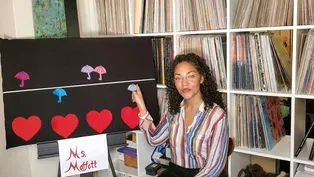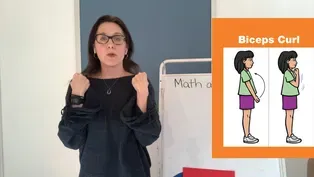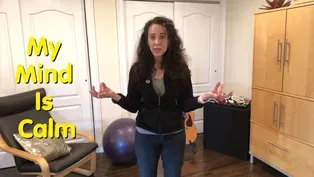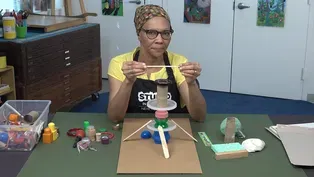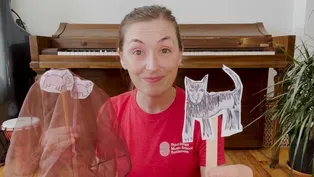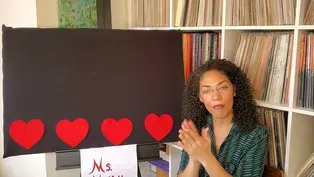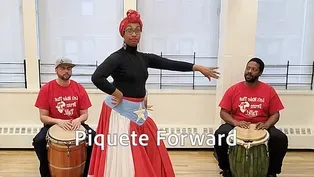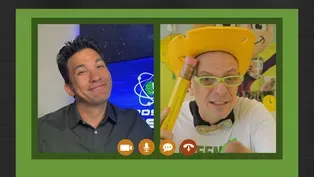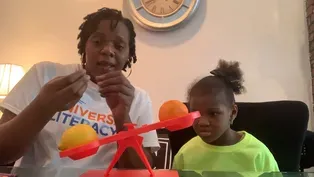
Can You Hear the Long “e” in Sleeping?
3/24/2021 | 56m 32sVideo has Closed Captions
Explore maps and what make makes animals happy, read HUSH, review long e, I, o.
Explore maps and what make makes animals happy, read HUSH, review long e, I, o. LET’S LEARN helps children ages 3-8 with at-home learning. One-hour programs feature instruction by educators and virtual field trips.
Problems with Closed Captions? Closed Captioning Feedback
Problems with Closed Captions? Closed Captioning Feedback
Let's Learn is a local public television program presented by THIRTEEN PBS

Can You Hear the Long “e” in Sleeping?
3/24/2021 | 56m 32sVideo has Closed Captions
Explore maps and what make makes animals happy, read HUSH, review long e, I, o. LET’S LEARN helps children ages 3-8 with at-home learning. One-hour programs feature instruction by educators and virtual field trips.
Problems with Closed Captions? Closed Captioning Feedback
How to Watch Let's Learn
Let's Learn is available to stream on pbs.org and the free PBS App, available on iPhone, Apple TV, Android TV, Android smartphones, Amazon Fire TV, Amazon Fire Tablet, Roku, Samsung Smart TV, and Vizio.
Providing Support for PBS.org
Learn Moreabout PBS online sponsorshipMore from This Collection
Video has Closed Captions
Read SCHOOL BUS and draw one, learn about prefixes and pitch, build sculptures. (57m 48s)
Running and Counting Both End in “ing”!
Video has Closed Captions
Move to improve, find the missing number, learn songs from Ghana, read ABUELITA’S SECRET. (58m 17s)
What Sound Does “aw” Make in Draw?
Video has Closed Captions
Read a story, discover "au" and "aw," learn about density, count, and move with music. (56m 58s)
Can You Find the Short “u” in Subtract?
Video has Closed Captions
Help Super Grover 2.0 solve a prickly problem, read ALL THE WAYS TO BE SMART. (56m 19s)
What Sound Does “gl” Make in Glove?
Video has Closed Captions
Play the glockenspiel, help Super Grover 2.0 make a cart move, read TWO WOOL GLOVES. (58m 9s)
Incredible Starts with Short “i”!
Video has Closed Captions
Solve problems with Super Grover 2.0, catch a rainbow, hear a piano sound like a cuckoo. (56m 9s)
What’s the Sound of “oo” in Book?
Video has Closed Captions
Explore animals’ form and function, sing about the 3 little pigs, read THE LITTLE BOX. (58m 15s)
We’re Reducing, Reusing and Recycling!
Video has Closed Captions
Learn all about rhythm and the number 9, read A BAG IN THE WIND. (56m 17s)
Video has Closed Captions
Learn to dance bomba and grow food in a city, read WOLF CUB’S SONG. (55m 20s)
How Many Syllables are in Invent?
Video has Closed Captions
Invent your own instrument, make 10 to add numbers to 20, read ONE GOLDEN RULE AT SCHOOL. (57m 36s)
Video has Closed Captions
Learn about the science behind mind reading, count shells, read MY BIG FAMILY. (57m 27s)
Which is Heavier: One Apple or Two Apples?
Video has Closed Captions
Defy gravity, learn secret code words for fast and slow in music, read WHOOO KNEW? (58m 5s)
Providing Support for PBS.org
Learn Moreabout PBS online sponsorship[upbeat music] - [Announcer] Ready to learn?
- [Both] Hi!
- [Announcer] It's time to share a story.
Read and write.
- Let's read it back.
- [Announcer] Discover science, sing.
♪ Somewhere ♪ - [Announcer] Play, and so much more.
- Cupcake!
- Very good.
- [Announcer] Stay tuned for lessons and activities.
- We're gonna start making some words, isn't that fun?
[upbeat music] Funding for this program was provided by The JPB Foundation.
- Hello, friends.
Welcome to story time.
My name is Parisa and I'm looking forward to our time together today.
Today we're going to read a book called, "Hush!"
And this is actually a Thai lullaby.
It's written by Minfong Ho and the illustrations are by Holly Meade.
The title is "Hush!"
You know I always like to read the title and look at the pictures on the cover of a book.
And sometimes the back too, because they give me clues as to what the book might be about.
So let's take a look at this picture, look at the illustration.
What is the mother doing?
Yeah, it looks like she's pointing her finger at her mouth.
She's covering her mouth like this, like she might be saying, hush.
She's holding a baby in her arm.
Hmm, why do you think she might be doing that?
Why do you think she's going like this?
And where do you think she's looking, or who do you think she's looking at?
I don't know.
Can you share with your trusted adult what you think this story might be about and then we'll read it together.
[playful music] So "Hush!"
is a lullaby from Thailand.
Do you know where Thailand is?
Thailand is at the heart of Southeast Asia.
And lullabies are songs or nursery rhymes that are often sung at bedtime.
Do you like to listen to lullabies, nursery rhymes, or songs when you're going to bed?
What do you like to do when you're getting ready for bedtime?
Yeah, I actually do like to listen to stories too.
Some of you may have thought of stories, maybe nursery rhymes, lullabies.
Perhaps this might become one of your favorite lullabies that you like to listen to when you're getting ready to go to bed.
So let's ready together, "Hush!"
Hush, who's that weeping in the wind?
Wee, wee, wee, wee, a small mosquito.
Mosquito, mosquito, don't come weeping.
Can't you see that Baby's sleeping?
Mosquito, mosquito, don't you cry.
My baby's sleeping right nearby.
Taka, taka, a long-tailed lizard.
Lizard, lizard, don't come peeping.
Can't you see that Baby's sleeping?
Lizard, lizard, don't you cry.
My baby's sleeping right nearby.
Hush, who's that creeping under the house?
Meow, meow, a lean black cat.
Black cat, black cat, don't come creeping.
Can't you see that Baby's sleeping?
Black cat, black cat, don't you cry.
My baby's sleeping right nearby.
Why do you think the mother wants all the animals to be quiet?
Why is she going, hush, and telling the different animals to be quiet?
Yeah, is it because her baby's sleeping?
Hush, who's that squeaking by the rice barn?
Cheep, cheep, cheep, cheep, a fat gray mouse.
Gray mouse, gray mouse, don't come squeaking.
Can't you see that Baby's sleeping?
Gray mouse, gray mouse, don't you cry.
My baby's sleeping right nearby.
Hush, who's that leaping by the well?
Op, op, op, op, a bright green frog.
Green frog, green frog, don't come leaping.
Can't you see that Baby's sleeping?
Have you noticed anything about the words that we've read so far?
Are there any that are similar or any that rhyme.
Yeah, you're right, there are some words that keep repeating.
So here, for instance, green frog, green frog, don't come leaping.
Can't you see that Baby's sleeping?
Green frog, green frog, don't you cry.
My baby's sleeping right nearby.
Some of the words are the same as previous pages.
The animal's different, the frog is different, right.
Here was a mouse, we had a mosquito, we had a lizard, but some of the words keep repeating.
Let's read and see the rest of the book is the same.
Hush, who's that sniffling in the sty?
Ot, ot, ot, ot, a muddy fat pig.
Fat pig, fat pig, don't come sniffling.
Can't you see that Baby's sleeping?
Fat pig, fat pig, don't you cry.
My baby's sleeping right nearby.
Hush, who's that beeping by the pond?
Oh, who do you think might be beeping by the pond?
What animal might be near water?
Gap, gap, gap, gap, a glossy white duck.
White duck, white duck, don't come beeping.
Can't you see that Baby's sleeping?
White duck, white duck, don't you cry.
My baby's sleeping right nearby.
Hush, who's that swinging from the trees?
Oh, what animal do you think will come next?
What animal do you know that swings from trees?
Jack, jack, jack, jack, a loose limp monkey.
Monkey, monkey, don't come swinging.
Can't you see that Baby's sleeping?
Monkey, monkey, don't you cry.
My baby's sleeping right nearby.
What do you notice about the words, the way it's written?
Do you notice some of the words are the same?
Yeah, they repeat, right?
There's a pattern.
There are certain parts of it that keep repeating.
There's one animal that's picked, right, and then the mom is speaking to that animal, and telling the animal to hush, because why?
Yeah, her baby's trying to go to sleep.
Hush, who's that sweeping at the hay?
Mua, mua, an old water buffalo.
Buffalo, buffalo, don't come sweeping.
Can't you see that Baby's sleeping?
Buffalo, buffalo, don't you cry.
My baby's sleeping right nearby.
Hush, who's that shrieking through the forest?
Hoorah, hoorah, a great big elephant.
Elephant, elephant, don't come shrieking.
Can't you see that Baby's sleeping?
Elephant, elephant, don't you cry.
My baby's sleeping right nearby.
Hush, is everyone asleep?
Is that what the mom is wondering?
The mother's saying, "Is everyone asleep?"
Does that mean all the animals are quiet now?
Let's take a look at the different animals, there's the frog, the duck, the pig, the buffalo.
It doesn't look like they're making any noise.
Maybe they're finally all asleep.
All is quiet, all is still, the mother dozes at the window sill.
Nothing's stirring, not a breeze, as the moon drifts up above the trees, there is no noise now, there is no sound.
Why do you think the mother's so tired?
She fell asleep at the window sill?
Yeah, she was so busy telling all the different animals to hush, because her baby's sleeping, right?
She got exhausted.
But guess what?
Only Baby's wide awake.
His eye's bright and round.
How could that be?
All the animals and the mom fell asleep but the baby did not.
So I hope you enjoyed this lullaby.
We are going to do an activity together.
I would like for you to think about maybe another animal that lives in Thailand, or you could pick your own favorite animal, and we're going to extend this lullaby.
So the same way that we noticed the words repeated and there was a pattern, we're going to use those words and you're going to think of an animal that hasn't been talked about in the story, and you're going to write about it, or just sing about it.
So here is something that's going to help us.
I took out this page right out of the book.
This was the page about the green frog.
So it says, "Op-Op, Op-Op, a bright green frog.
"Green frog, green frog, don't come leaping.
"Can't you see that Baby's sleeping?
"Green frog, green frog, don't you cry.
"My baby's sleeping right nearby."
So I'm going to take this tape off, and those are the places that you will fill in the blank with your animal that you pick.
First, you need to pick the animal that you'd like to use in here.
And you have to think about the sound that it makes.
So for example, if you picked a bird, you might say, chirp, chirp, a bright feathery bird.
Feathery bird, feathery bird, don't come chirping.
Can't you see that Baby's sleeping?
Feathery bird, feathery bird, don't you cry.
My baby's sleeping right nearby.
So pick your favorite animal or maybe if you wanna do some research and find other animals that are native or that live in Thailand, with your trusted adult, you can do that.
And you can extend this, and if you'd like you can do this multiple times and create your own book of this wonderful lullaby called, "Hush!"
I hope you enjoyed it.
See you later, friends.
It was nice spending this time with you.
- Hi, movers and shakers, this is Violet and I'm here with my sister, Ivy.
- Hi.
- And we have a song for you today that also has a game, and it's called "The Name Game".
So we're gonna sing it for you.
Whose name should we use first?
- Let's do yours.
- Okay, all right, ready?
♪ Violet, Violet, bo biolet ♪ ♪ Banana fana fo fiolet ♪ ♪ Mi my mo miolet, Violet ♪ - Did you catch that?
All right, let's try it with your name now.
- All right.
- All right, ready?
♪ Ivy, Ivy, bo bivy ♪ ♪ Banana, fana, fo fivy ♪ ♪ Mi my mo mivy, Ivy ♪ - Have you ever heard of this song?
It's a funny one.
And you can hear the pattern?
I wonder if you could do it with your own name.
So how it works is, you start with your name and if your name doesn't start with a vowel, like mine, you replace the first sound with a different sound for each part of the song.
So first, we say our name, in my case, Violet, and then every time after that, we're going to change the first sound.
First with a B sound, with a B.
Then with a F sound, an F. And then lastly, a mm sound, with the sound that M makes, right, mm.
So it's Violet, biolet, fiolet, miolet.
And Ivy's name starts with a vowel, and so instead of switching the first sound you just add the first sound in front of it.
So what would your name be then for the sounds?
- So it's Ivy, bivy, fivy, mivy.
- Isn't that silly?
All right, we're gonna sing it once again, slowly with each of our names, and then we wanna hear you sing it with your own name.
All right, so we're gonna start with Violet and we'll do it slowly.
♪ Violet, Violet, bo biolet ♪ ♪ Banana fana fo fiolet ♪ ♪ Mi my mo miolet, Violet ♪ - Did you hear those sounds?
All right, listen to them, we're gonna try it with Ivy's name.
♪ Ivy, Ivy, bo bivy ♪ ♪ Banana fana fo fivy ♪ ♪ Mi my mo mivy, Ivy ♪ - All right, do you think you can do it?
- I think you can.
- Okay, let's hear you do it.
Ready?
Great job.
Thanks, everyone.
We'll see you next time.
- See you next time.
[upbeat music] - Hi, friends.
It's me, Isabel, and welcome to my learning corner.
Today we're going to be learning about short words, also known as one syllable words that end in a vowel.
They do something very interesting.
Are you ready to find out what that is?
Great, let's get started.
In our first activity of the day, we are going to begin by segmenting words.
When you segment a word, you break the word down into all of the sounds that you can hear.
Which means, you need to be a very good listener.
So before we start, we should tune up our ears, that's right.
Let's go!
[tube whirring] Good job.
Now I'm going to say a word, you're going to repeat the word and then together, we will chop out all of the sounds like a lumberjack, that we hear in the word.
Let's try it with the word plane.
Can you say that word?
Good job.
Let's go, P, L, A, ne, plane, good job.
Now I'm gonna say the next word, and you're gonna repeat after me.
Ready?
The word is chin.
Can you say that word?
Now you're going to say the sounds before I do.
Ch, I, N, chin, good job.
The next word is she.
That's a short word that ends in a vowel.
The word is she.
Can you say that word?
Good job!
Let's chop it out.
Sh, E, she, good job!
Let's try another short word that ends in a vowel.
The word is shy.
Good job repeating that word.
Ready?
Sh, I, shy, good job.
Let's try one more word, the word is wait.
Wuh, A, T, good job, wait!
Yay!
Now we're going to take a closer look at those short words that end in a vowel.
Come on and have a seat.
Do you remember the question that I asked at the beginning of our time together?
I was wondering what would happen to a short word or a one syllable word that ends in a vowel.
How is that a different type of word?
Well, I have a short word that ends in a consonant, let's say this word together.
M, E, me, N. Men.
Men.
This is a closed syllable word.
There is a short vowel in the middle, the vowel is making its short sound, and it is closed in by a consonant.
But if I take this consonant away, now it's no longer closed, it's an open syllable word.
Can you say this word?
Let's see.
M, E, me.
You were right.
What happens to this word?
If it is a short word that ends in a vowel, it's an open syllable word, which means the vowel will say its name or its long sound.
Let's try a couple more words to see what I mean.
Here is the next word.
Let's tap and say this word.
Remember, because it's an open syllable word, there's no consonant here.
The vowel I will say its name or its long sound.
H, I, hi.
Hi!
Hi!
Let's try another word.
Again, it is an open syllable word ending in a vowel, so the O will say its name or its long sound, good job.
G, O, go.
Excellent reading today.
Now I wanted to build one more word that uses the letter S at the end of the word in a very special way.
Let me start by building this word.
Can you say the sounds?
Ch, I, ck, chick.
A baby chicken.
Now I'm gonna add this special form of punctuation.
It's called an apostrophe.
It shows ownership, followed by the S, apostrophe S. Chick, chick's, that means the chick owns something.
What could it own?
It's mom.
Chick's.
Now we're going to use everything we've learned so far in order to read words quickly and accurately.
What do you notice about these words on the first line?
Which word shows ownership?
I see the apostrophe S right there.
And what do we notice about all of these words?
That's right, they're all open syllable words.
Now we're ready to read.
Sh, E, she.
H, I, hi.
S, O, so.
H, E, he.
M, O, M, S, mom's.
She, hi, so, he, mom's.
Let's go to the second line.
This shows ownership.
D, O, G, S, dog's.
W, E, we.
N, O, no.
G, O, go.
B, E, be.
Dog's, we, no, go, be.
Next line, sun, set, sunset.
F, act, fact.
B, R, im, brim.
Bath, mat, bathmat.
Sunset, fact, brim, bathmat.
You're getting really good at this, guys.
Log, jam, logjam.
Th, E, F, T, theft.
F, E, N, D, fend.
House, boat, houseboat.
Logjam, theft, fend, houseboat.
Let's use everything we've learned to read two sentences.
This land's cliffs are so pretty!
This land's cliffs are so pretty!
We have read the kit's plans.
We have read the kit's plans.
Good job!
Now we're going to write two words to really cement our learning.
Go ahead and take out a pencil or something to write with and a piece of paper or something to write on.
[upbeat music] Are you ready for a dictation?
Great!
Today, we're going to be writing down two words that end with the letter S. In one word, that S is going to represent more than one of something.
And in the other word, that S is gonna be preceded by our apostrophe.
It's going to show ownership using the apostrophe S. Are you ready?
The first word comes from our first sentence we just read.
This is the sentence, this land's cliffs are so pretty.
In that sentence, we're talking about the cliffs, which are mountains, that belong to the land.
Here is the word we're gonna focus on, land's.
Can you say that word?
Now, let's tap out the word land.
L, A, N, D, land.
Let's add that apostrophe S, land's.
Okay, go ahead and write the word.
Good job!
Good job!
Tell me what to write now.
L, A, N, D. How do we show ownership again?
That's right, I add the apostrophe S. The word is land's.
Now we're going to try a new word.
In the second sentence we wrote, we were talking about plans.
We have read the kit's, that's like the big box with the set inside of whatever you want, probably Legos.
The kit's plans.
So now we're going to write the word plans.
What's that word?
Does it have a suffix?
Yes, it does, the letter S. The word by itself is, ready to tap?
P, L, A, N, plan, S, plans.
Go ahead and write the word plans down now.
Good job!
Let's go ahead and write it together.
P, L, A, N, S. I have more than one plan.
Yay!
Thank you for helping me answer the question, what happens if I have a short word, or a one syllable word that ends in a vowel?
That vowel is going to say its name or its long sound.
Thank you, friends.
I have a challenge for you.
With a trusted adult, any friends around, I would like you to look for those open syllable short words that end in a vowel.
See how many you can find.
Until next time, don't forget to watch the next episode, I'll see you soon.
Bye, friends.
[upbeat music] - As a parent, I know I'm child's first, and most important teacher.
So I'm constantly looking for learning opportunities.
What I've discovered is that they're everywhere.
- Five, four, three, two, one, zero.
- Good.
- [Woman In Purple Shirt] Whether we're at home, on the bus, or in the park, there's always something I can do to get my little one thinking and learning.
The more my child learns outside of school, the more prepared he'll be for the classroom.
Plus, learning together can be really fun.
Children learn best during activities that are part of their everyday routines.
- Four, five, six.
- [Woman In Purple Shirt] So we practice basic math skills like counting and number recognition, all through the day.
- I spy with my little eyes, number six.
Yay!
- When we go for walks around the city, I talk with my child about math concepts like sizes, shapes, and patterns.
Comparisons are his favorite.
[speaking foreign language] At home, laundry is a perfect chance for us to work together on matching and sorting.
Can you help me find the other blue sock?
Good job.
When I introduce math to my child early on, I'm giving him a headstart in school and in life.
My little laundry sorter might just be tomorrow's rocket scientist.
[upbeat music] - Hey, everyone.
You are just in time, because the zoo just opened.
Now while we're outside, I'm going to be wearing this mask, because there's a lot of guests around, and I wanna make sure that I'm safely walking around them.
But my name is Max and I am an animal interpreter, here at the Memphis Zoo, in Memphis, Tennessee.
And my job is that of a zookeeper, but I also get to talk to people about how cool animals are.
And today, we're going to be talking about secondary needs.
So why don't we head into one of our classrooms where it's nice and warm, and we can talk about what secondary needs are.
Let's go.
[gentle music] All right, welcome to the classroom.
Now that we're inside and there's no other guests around, I can take my mask off and we can talk more about what secondary needs are.
First we need to talk about how secondary needs are different from basic needs.
Basic needs like food, water, shelter, space, you have to have in order to survive.
Secondary needs, you don't need to survive, but they help to make you happier and healthier.
For example, do you see this bin full of newspaper?
This is not important to survive, however this bin of newspaper can make several animals very happy.
Let me show you how.
Now for a legless lizard like Dan, they may really enjoy exploring this box.
Not because this box helps them to survive, but it is a lot of fun for him, and when you can do things that are fun, it makes you happy.
And the more things that make you happy, the healthier you are as well.
And here at the zoo, we like to make sure that we keep ourselves happy as well as our animals.
Now you may be wondering, how do you know what Dan thinks is fun?
How do you figure out what his secondary needs might be?
Well, for each animal that lives at the zoo, we make sure to do as much research as possible about them.
We learn about their individual behavior, or their personality.
And how they live in the wild.
And those two things helps us to find what would be fun for animals, or what fits their secondary needs.
For example, we know that Dan loves to explore for his personality.
And for his secondary needs, we know that Dan or legless lizards, like to go digging around in loose soil.
So for enrichment, we like to give Dan all types of things to go dig through, because he finds it fun.
Here you can you see Dexter, our short-tailed opossum utilizing enrichment.
We'll talk more about what enrichment is later in the program, but for now, we'll say that it's an object that we can give our animals that can be physically or mentally stimulating.
And the enrichment or objects that we give our animals may encourage them to behave how they would in their natural habitat in the wild.
With Dexter here, we just gave him a ladder and some new pieces of twigs, so that he may utilize a behavior that he would do in the wild, which is to climb around trees and branches.
Taking a walk outside could be considered enrichment for people, think of all the different sites, sense, and sounds that you're taking in.
Very exciting stuff.
And even though a leisurely walk may not be essential or important for our survival, it definitely makes life more interesting.
I hope learning about these animals has gotten you thinking about how you, at home, meet your own secondary needs.
Do you enjoy spending time with family and friends?
Does it make you happy?
If you said yes, then you may be able to relate to the domestic rat.
Domestic rats are social animals.
Other social animals can include rats, dolphins, chimpanzees, monkeys, even otters, just to name a few.
All these animals enjoy spending time in a group or hanging out with one another.
And in these groups, they may have something called a social hierarchy.
Which means, there may be one or two animals that are in charge of the group.
And each individual in that group, has their own personality.
A domestic rat needs to live with at least one other rat because of how social they are.
If a rat has to live by themselves, then they may start to get stressed out and anxious.
So they may not have to live with a friend for survival, but it is extremely important to have social behavior to keep the rats happy and healthy.
Now secondary needs can change based on the animal and their individual personality.
Unlike the rats, not all animals need to be social or to hang out with other animals.
Some like to be alone.
And that's called being solitary.
Savannah monitors like Matthew here are a great example of a type of animal that is more comfortable by themselves.
However, that doesn't stop him from wanting to hang out with his keepers every now and then.
Now one of our challenges here at the Memphis Zoo is to make sure that in the habitats we provide for our animals, their secondary needs are met.
And one of the ways we do that is by giving them options.
I'm currently in front of our African elephant exhibit.
Where you'll notice that our outdoor yard is separated into three different areas.
And that's to give the elephants choice as to whether they want to go be by themselves or if they want to socialize a hang out with the other elephants.
We also give them options on how they can become more comfortable.
For example, during the summer when it's really hot, they can go swimming in that large pool to cool off, or stand in a nice shady spot.
During the winter, when it's really cold, they can go inside that large building behind me, which is the elephant barn.
And in there, they each have their own area where they can get nice and cozy.
Kind of like having an elephant sized bedroom.
We also like to give them their food in different ways.
Sometimes we'll be training with them, or sometimes if you look above me, we'll put food in those large barrels there which acts as enrichment.
It makes it a little bit more interesting for the elephants when they wanna eat, 'cause they have to use their brain and they have to use their muscles to stretch out with their trunk and grab that food.
Kind of like how you stretch when you wake up in the morning.
Now keep in mind that you don't have to build a large yard or a contraption or a machine to help an individual meet their secondary needs.
Much of the time, there are small things around the house that you can use to enrich not only yourself, but an animal as well.
Let me show a few of those examples.
Now as an animal interpreter here at the Memphis Zoo, we like to use lots of different kinds of enrichment for our animals.
And enrichment are different kinds of objects or things that you let your animals interact with that helps to keep them happy and healthy.
Which means it meets their secondary needs.
And enrichment can be something from the pet store that they can play with.
Like that hanging thing, or this rubber ball here.
Enrichment can also be recycled stuff from around your house.
For example, we have all these pieces of cardboard that you can hide snacks into.
Newspaper is great enrichment, especially business and finance.
'Cause it gives them something to climb through if you shred it up, or you can put treats into it and hide it around their enclosure.
We even have some bones or spices that you can use for their sense of smell.
Or my personal favorite, cardboard boxes.
Because it creates a great hide or house for the animals, or in my case, it also makes for a great hat.
But we wanna make sure that the enrichment we give our animals utilizes all of their senses.
A lot of animals, based on their lifestyle, enjoy using their sense of smell.
Sometimes, we will use different scents like perfume or spices to encourage an animal to explore.
By spreading these smells around an area, we encourage the animals to sniff around, check things out, and to explore as well.
It helps to keep them stimulated mentally and physically.
Now other than smell, we can give enrichment to interact with our animals other senses.
For example, for an animal's sense of touch, we can give them different textures or fabrics, like this very soft pillowcase.
Or even some stuffed animals.
We can also give them feathers for them to explore as well.
For an animal's sense of sight, we can give them cool things to look at, like this mirror here so they can check our their reflection.
For their sense of taste, we can give them all kinds of treats, like some corn, maybe a delicious strawberry, or even some peanuts for them to crack.
And for their sense of hearing, sometimes we can play sound effects or even music for them.
We even have enrichment to get our animals to move around, like giving them a ladder to climb, or even hanging a tray and smearing some treats on the top of it, so that animals have to balance as they reach their food.
These are just a few of the different types of enrichment we give our animals that engages all of their animal senses.
Now we do have to make sure that the enrichment or the items and treats that we give our animals is healthy for them.
Because if the enrichment is dangerous, that is not meeting our animal's secondary needs.
So we make sure to do a lot of research about what is safe for the animals and we talk to our excellent vet staff as well.
And when we give them something new, like a feather, we make sure to watch our animal interacting with it for a couple of hours, to make sure that they're using it in a way that is safe for them.
Well, my friends, now we've talked about just a few examples of how animals meet their secondary needs.
And remember, secondary needs can change depending on your individual personality and lifestyle.
So before we end today's lesson, I wanna ask you at home, what do you like doing for fun?
What makes you happy?
For me, it's probably reading a book about pandas and getting to talk to my friends just like you.
All right, everyone, that's gonna do it for our lesson today, but let's review what we learned.
Today we talked about secondary needs for animals and people.
And secondary needs are different from basic needs, because you don't have to have them to survive.
Secondary needs make you happy.
And they can defer based on your personality.
So if you have something you will enjoy that other people may not, that's okay.
The most important thing is that we respect the differences for all animals and people.
On that note, it was wonderful to see you all, I hope you have a great rest of the day, and I'll see you soon.
Bye, folks.
[light music] [speaking foreign language] - Five, four, three, two, one, zero!
- Good.
[speaking foreign language] - Four, five six.
[speaking foreign language] - I spy with my little eyes number six.
Yay!
[speaking foreign language] - Can you help me find the other blue sock?
Good job.
[speaking foreign language] [upbeat music] - Hi, I'm Andrew, and I am back with another video about the built environment in your community.
So today we're going to be talking some more about maps.
What is a map?
A map is a special kind of picture that shows a place.
It shows what a place looks like.
When do people use maps?
You use a map when you need to see what a place looks like, so you might use a map if you're lost to help you find your way around, or you might use a map to help you get from one place to another.
How do maps tell us where something is that we want to visit in the place, like a restaurant or a bus stop or some other thing in the place that we're looking at?
Maps use special small pictures called symbols to show us the location of different things.
Let's spell that word together.
Symbol, S-Y-M-B-O-L, symbol.
A symbol is a picture that gives us information.
So when we see symbols on a map, it tells us where something is that we might want to see.
Could be a restaurant or transportation, like a bus or a train to help us get around, or something else that people might want to visit.
In today's video, we're going to be looking closely at a map and looking at the way symbols are used on that map.
Have you ever looked at a map of your community?
Next we're going to look at a map of a community in New York City.
And we're going to see what kind of information this map can tell us about that place.
Here is our community map.
What do you see in this picture?
I see a lot of different lines and shapes.
I see a lot of different colors as well.
Let's look at those colors.
What do you think the blue color on this map is showing us?
The blue color on the map represents water.
It's showing us where there is water in this map.
What about the green color?
What do you think the green color is showing us?
When you see green on a map like this, it means that there's a green space there.
So that could be a park, or a playground.
It's a place that has grass or trees.
So green stands for green spaces in the community.
What about those white lines?
What do you think the white lines on this map represent?
The white lines on the map show us different streets or roads.
Do you see any shapes in the white lines?
Some of the white lines make a shape that has two short sides and two long sides.
A shape with four sides, two short and two long.
Do you know what the name of that shape is?
That shape is a rectangle.
So some of the streets on this map make rectangles, but not all of them.
Some of them don't make a shape with straight lines.
I also see another color, this yellow.
That shows us a highway, so a different type of road.
And then of course, the gray color, if we know that the blue color stands for water, what do you think the gray color shows us?
The gray color shows us where there is land on this map.
So all these different colors are showing us information before we even start looking more closely at the symbols and words on the map.
Do you see the symbols on this map?
They're little pictures that are next to the names of different businesses or different types of building that you could visit in the community.
How many different symbols can you find when you look at all the symbols on this map?
Take a moment to try to count how many symbols you can find and then we'll count them together.
[upbeat music] When I look at this map, I can see the following symbols, one, two, three, four, five, six, seven, eight, nine, 10, 11, 12, 13.
There are 13 different symbols that I was able to find on this map.
Next we're going to look more closely at some of those same symbols that were on this map to see what information they're telling us about the community.
Here's an example, this is one of the symbols that was on the map that we just looked at.
What does this symbol show us?
What does it look like?
This symbol is showing us a train.
So when you see this picture of a train on the map, what do you think that means?
It's showing us where there is a train you can take, it's showing us transportation.
So the train symbol means there's a train stop there.
What does this symbol show us?
This symbol is a shopping cart.
Where do you use a shopping cart?
You would use a shopping cart when you go to the grocery store.
So what do you think this symbol stands for?
It stands for a grocery store.
It's showing us where there is a grocery store on the map.
What about this symbol?
Do you know what this symbol means?
This is a knife and a fork.
Where do you use a knife and a fork?
You use a knife and a fork when you are eating.
And what's the name of a place where you can eat food?
It's called a restaurant.
So this symbol, the knife and fork represents a restaurant.
You can see that a lot of these symbols are chosen because they look like something that has to do with the place.
Something that you would use when you are visiting that place, like the shopping cart you would use at a grocery store, or the knife and fork, you would use at a restaurant.
Let's look at another example.
This is a special hat that people wear when they're graduating from school.
So if this is a hat that people wear at school, then what do you think this symbol means on the map?
This symbol means there is a school there.
This symbol shows us where we can find a school.
Do you know what this symbol means?
This symbol is a dollar sign.
It's the symbol that you would see on money.
So where would be a place where money is stored?
A place where people can get money from?
This symbol represents the bank.
So when you see the symbol for money, it means that there's a bank there.
Do you know what this is a picture of?
This is a picture of a shopping bag.
Where would you use a shopping bag?
You would use a shopping bag when you are buying things at a store.
So because this is something you use at a store, we know that this represents a store.
And let's do one last one.
Do you know what this symbol represents?
This is a picture of a gas pump for a car.
Where do cars get gas from so that they can drive?
Cars get gas at a gas station.
So this is a gas station symbol.
These are just a few examples of some of the many symbols that you can find when you look at maps.
Next you are going to make a map of your street that you live on.
To do this, remember what a street looked like on the previous map?
The streets look like a line, so we're going to start by drawing the line on paper that shows what your street looks like.
Then you're going to draw the building where you live and draw whatever is around that building.
You can ask an adult for help to figure out what different types of buildings there are on your street.
Here's an example, this is a drawing of the street that I live on, that I made.
So as you can see, I drew the street as a line, and then I put my building.
I also showed that at one of the street, there is a park with some benches and trees.
I also drew some other buildings such as a grocery store and another apartment building across the street.
After you've finished your drawing of your street, you can share it with an adult and talk about the different kinds of buildings that you found.
If you're done with that, you could also draw a bigger map that shows your whole community, instead of just one street, you could show some of the other streets that are near where you live in your neighborhood.
You can also ask an adult to help you put some symbols on the map.
For example, if there's a grocery store on your map in your neighborhood, what symbol represents a grocery store?
Do you remember what symbol we used for that one?
That one was a shopping cart.
So you could draw a little picture of a shopping cart to show where there is a grocery store.
You can use symbols so that people can learn information from your map.
Join us next time for another activity about the built environment in your community.
Bye.
- [Announcer] Funding for this program was provided by The JPB Foundation.
[gentle music]
Let's Learn is a local public television program presented by THIRTEEN PBS
